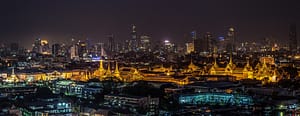The first “Thailand” in recorded history is said to be the Kingdom of Sukhothai, which was established midway through the 13th century. Sukhothai continued to grow and develop, becoming the leading kingdom in the region until the mid-14th century, when it was overshadowed and by the ascending Ayutthaya Kingdom.
Ayutthaya is located in the Mae-nam or Chao Phraya valley, which allowed them to expand rapidly as it traded with neighboring states such as China, India, Persia, and European merchants. By the 16th century, they were a dominant power and occupied the legendary site of Angkor from the Khmer Empire, and eventually absorbed northern Thailand’s Lanna Kingdom. In 1767, Ayutthaya was ransacked by an invading Burmese army, and subsequently destroyed. Upon its demise, the King of Siam (as Thailand was formerly known), King Taksin, moved the entire population to Thonburi and founded a new capital, still upon the Chao Phraya River. After 15 years, his successor, King Chakri, moved it again to its present day location of Bangkok. This became known as the Chakri Dynasty, which still continues to this day.
As colonialism shaped Asia between the 18th and 20th centuries, and all of its neighbors succumbed to European powers, Thailand remained a sovereign state. It used the British and French rivalry to create a buffer zone between the nations. French Indochina and British Asia became separated by Thailand, but still largely influenced the country. In 1932, the first of 17 Thai military coups took place. Absolute monarchy was replaced by a Constitutional Monarchy, vesting political power in the people.
After more than a dozen governments toppled through military coups in the 1980’s, Thailand became a leading Southeast Asian nation, with a stable economy from thriving agriculture and tourism. However, it was responsible for setting off the Asian economic crisis of 1997 which hit the country hard.
In 2006, a bloodless coup overthrew Thaksin Shinawatra’s democratic government, following widespread allegations of corruption and power monopolization, which has led to an ongoing divide between the urban elite/middle class and rural poor.
Buddhism blankets much of Thailand, except for the heavy Muslim influence in the south. Temples, which are known as wats in Thai, are ubiquitous throughout the country, known for their golden decorations and ornate buildings. In Bangkok, Wat Pho, Wat Arun and Wat Phra Kaew are among the most visited sites in the country. Chiang Mai’s Wat Phra Doi Suthep is another famous temple worth exploring.
There are numerous etiquette rules which should be abided, which first and foremost is to respect the monarchy. Any bad talk about the King or his family is strictly forbidden. Touching another person’s head is taboo, as is pointing the feet. Light skin is a symbol of wealth, and as Westerners have tanning salons, the Thais have whitening salons, coupled with many brands of cosmetic pastes meant to lighten the skin. Spirits are also a large part of Thai culture, which is why almost everyone seems to believe in ghosts. Spirit houses are the norm outside most residences and office buildings.
The main sport in Thailand is boxing, which is also known as “Muay Thai.” It is the art of nine deadly weapons, with fighters using the fists, elbows, knees, and legs to down their opponent. Football is another popular pastime, with the English Premier league being showed on television almost every day.

